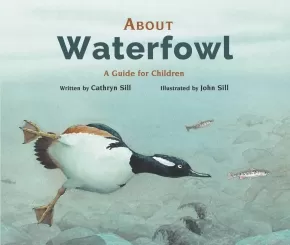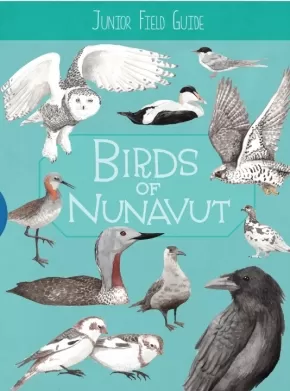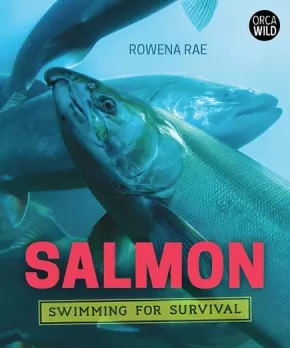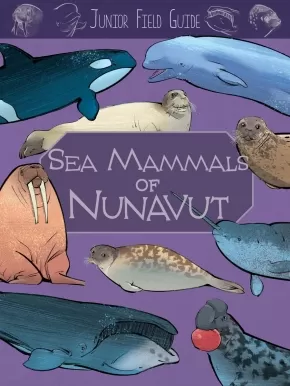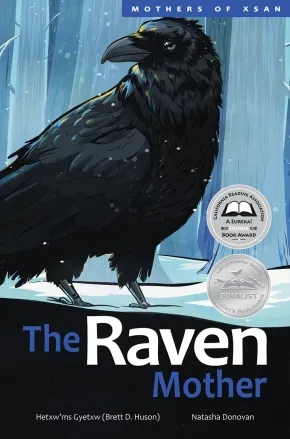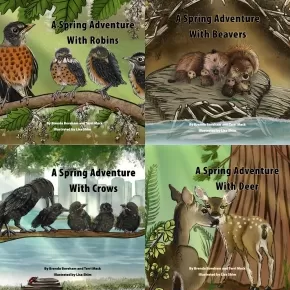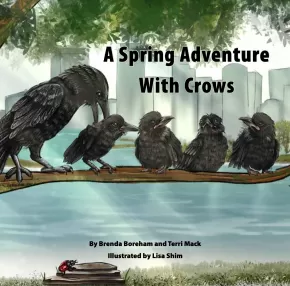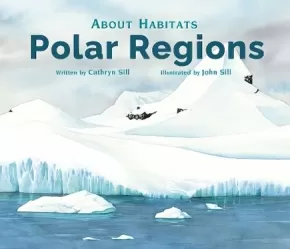
Ecosystem
31
-
45
of
92 Results;
Sort By
Go To
of 7
About Waterfowl: A Guide for Children
$24.99
Artists:
Format:
Hardcover
ISBN / Barcode: 9781682632345
Synopsis:
Synopsis:
An informative and entertaining introduction for young children to the amazing birds that live near water in all types of habitats.
In this addition to the About… series, award-winning author Cathryn Sill uses simple, easy-to-understand language to teach children what waterfowl are, where they live, what they eat, and how they move.
John Sill’s detailed, full-color illustrations show the characteristics of different types of waterfowl—from the Trumpeter Swans of northwestern North America to the Bar-headed Geese of central Asia.
Young learners who may only be familiar with the ducklings and geese on local ponds and lakes will be delighted to discover the amazing variety of waterfowl in the world. A glossary and afterword provide further fascinating details about waterfowl that will inspire readers to learn more.
Educator & Series Information
Recommended for ages 3 to 7.
This book is a part of the About Habitats series.
Additional Information
48 pages | 10.00" x 8.50" | Hardcover
Arctic Animal Life Cycles: Mammals - Nunavummi Reading Series
$12.95
Artists:
Format:
Paperback
ISBN / Barcode: 9781774505724
Synopsis:
Synopsis:
Learn about food chains in the Arctic!
This book explores the concept of the food chain using Arctic plants and animals.
Educator & Series Information
Recommended for ages 6 to 8.
This book is part of the Nunavummi Reading Series, a Nunavut-developed series that supports literacy learning while teaching readers about the people, traditions, and environment of the Canadian Arctic. It is a Level 8-11 book in the series.
Nunavummi Reading Series books have also been officially levelled using the Fountas & Pinnell Text Level Gradient™ Levelling System. F&P Level of this book: N.
Additional Information
36 pages | 8.00" x 8.00" | Paperback
Birds of Nunavut
$14.95
Artists:
Format:
Paperback
Text Content Territories:
Indigenous Canadian; Inuit;
ISBN / Barcode: 9781774505625
Synopsis:
Synopsis:
There are a lot of different types of birds living in Nunavut. From snowy owls to rock ptarmigans, learn all about what each bird looks like, how they live, what they eat, their migration patterns, and more. This science book combines colourful illustrations and photographs in a handy field guide filled with interesting facts about birds.
Educator & Series Information
Recommended for ages 8 to 10.
This book is part of the Junior Field Guide series. Perfect for learning all about living things in the Arctic! These Junior Field Guides give information and interesting facts about the different animals that live in Nunavut.
Additional Information
32 pages | 7.50" x 10.00" | Paperback
Fernwood Forest
 $21.95
$21.95

Artists:
Format:
Hardcover
ISBN / Barcode: 9781771745994
Synopsis:
Synopsis:
Join us on a bright, sunlit day in the middle of May as we wander the quiet trails of a secluded woodland. Here, we catch glimpses of the daily activities of many creatures—from a pair of black-tailed deer to a colony of carpenter ants—that make Fernwood Forest their home. We also learn about the three layers of the Pacific Northwest temperate rainforest and explore interesting facts about forest plants and animals.
Fernwood Forest is part of the By Day and By Night Nature Series. Books in this series focus on a specific habitat and explore the many connections within a healthy ecosystem. Through lyrical stories, supportive illustrations, labelled diagrams, and nature notes, readers learn about living and non-living parts of the ecosystem.
Additionally, readers can:
-
use a picture clue on each page to predict the animal featured on the next page
-
count animals as their numbers increase in each illustration
-
search for an animal that travels from page to page
-
discover patterns in the text and structure of each book
-
track the movement of the sun or moon across the sky
Educator & Series Information
Recommended for kindergarten to grade 4.
This is a fictional story with factual information about the Pacific Northwest temperate rainforest.
Search for a bee that travels from page to page in this story!
Each book in the By Day and By Night Nature Series focuses on a scene typical of a distinct west coast habitat, showing how living and non-living things are connected in a healthy ecosystem. As readers, we observe animals going about their daily activities: caring for their young, searching for food, and responding to the changes in light, temperature, and weather conditions throughout the day or night. The last four pages of each book provide facts about the highlighted animals and plants as well as features that are unique to their habitats. The final page suggests ways that young readers and their families can be respectful as they visit wilderness areas.
Readers with a sense of curiosity will find opportunities in these books to:
- use picture clues to predict the featured animal on the next page
- identify, count, and sequence numbers (1 owl, 2 deer, 3 squirrels, etc.)
- search for small creatures that travel from page to page
- discover patterns in the text and structure of the books
- track the movement of the sun, or moon, across the sky
Curriculum Links
Reading - Providing opportunities for guided practise in using reading strategies: visualizing, making connections, asking questions, transforming, and inferring.
Science - Supporting discussion and further exploration:
- characteristics of living things
- needs of living things
- connections between living and non-living things
- daily and seasonal changes
- animal growth and changes
- plant growth and changes
- weather
- habitats
- observable patterns in the sky
Numeracy - Counting and sequencing of numbers 1 to 10.
Social Responsibility - Initiating discussions about ways to take care of wilderness areas.
Additional Information
32 Pages | 8.5" x 11" | Hardcover | ISBN: 9781771745994
32 Pages | 8.5" x 11" | Hardcover | ISBN: 9781771745994
Salmon: Swimming for Survival
$24.95
Format:
Hardcover
Text Content Territories:
Indigenous;
ISBN / Barcode: 9781459826533
Synopsis:
Synopsis:
Salmon: Swimming for Survival introduces us to the dramatic life story of salmon.
These fish hatch in streams, swim extreme distances out to sea, and then migrate home to where they were born to produce the next generation. But today their habitats and very survival are threatened by human activity. This book looks at the unique biology of salmon, their importance to many Indigenous communities, their cultural and economic impact and the vital role they play in ecosystems. With profiles from scientists, educators, fishers and more, learn about the people who are working hard to change the uncertain future of salmon and improve the chance that these iconic fish can survive for generations to come.
Reviews
“A wealth of good, up-to-date information...This comprehensive book has a great deal to offer to help everyone understand the critical nature of salmon conservation. Highly Recommended.” — CM: Canadian Review of Materials
“This informative book...takes a complex subject and breaks it down into parts that are easy to comprehend. Recommended.” — School Library Connection
Educator & Series Information
This book is part of the Orca Wild series that examines the intricacies of animals, ecosystems, humans and our relationships to each other.
Recommended for ages 9 to 12.
Includes some Indigenous content.
Additional Information
112 pages | 7.50" x 9.00" | Hardcover
Sea Mammals of Nunavut
$14.95
Artists:
Format:
Paperback
Text Content Territories:
Indigenous Canadian; Inuit;
ISBN / Barcode: 9781774505854
Synopsis:
Synopsis:
Learn about what kinds of sea mammals live in the Arctic! From narwhals and belugas to walruses and ringed seals, this nonfiction book introduces young readers to wildlife in arctic waters.
An exciting addition to the collection of Junior Field Guides from Inhabit Education Books!
Educator & Series Information
Recommended for ages 8 to 10.
This book is part of the Junior Field Guide series. Perfect for learning all about living things in the Arctic! These Junior Field Guides give information and interesting facts about the different animals that live in Nunavut.
Additional Information
32 pages | 7.50" x 10.00" | Paperback
Sharks Forever: The Mystery and History of the Planet's Perfect Predator
$24.95
Format:
Hardcover
ISBN / Barcode: 9781459827561
Synopsis:
Synopsis:
Explore the latest science about sharks.
Did you know that some sharks have friends? Or that there are sharks small enough to swim in a soup can? There are sharks who can walk on land and others who make their own light. There are ancient sharks who lived in the oceans millions of years ago, and new species who have just been discovered. Most importantly, did you know that most sharks are fighting for their survival?
Sharks Forever takes a deep dive into the lives of sharks––their habitat, biology, habits and personalities. It also looks at the biggest threats to their existence, from marine pollution and overfishing to bycatch and shark-fin soup. It goes beyond the bites and shares stories about people who swim with sharks and call them friends.
Reviews
“A wealth of fascinating research about sharks...If you weren’t a fan of sharks before reading Sharks Forever, you will undoubtedly come away with a new perspective. This up-to-date and comprehensive book will go a long way in convincing readers of the value of one of the world’s top predators and its rightful place in ocean ecosystems. Highly Recommended.”— CM: Canadian Review of Materials
“A passion for sharks shines through…A great addition to a unit on ocean life, ecosystems, apex predators, or conservation.”— Children's Literature
“An important book that’s fun to read. Sharks Forever presents beautiful images, captivating information and engaging stories, while underscoring the importance of shark conservation. It achieves something rare—a connection with sharks as individuals. We get insights into their communication, personalities and friendships. This is the shark book the world needs.”— Julia Barnes, Sea of Life filmmaker
“You’re either fascinated by sharks or terrified of them. Regardless, Sharks Forever is informative and offers fascinating insight into not only the science of sharks but their undeniable impact on the human race.”- Madison “Shark Girl” Stewart, filmmaker and activist
Educator & Series Information
This book is part of the Orca Wild series that examines the intricacies of animals, ecosystems, humans and our relationships to each other.
Recommended for ages 9 to 12.
Additional Information
99 pages | 7.50" x 9.00" | Hardcover
The Raven Mother
$24.95
Artists:
Format:
Hardcover
Text Content Territories:
Indigenous Canadian; First Nations; Gitxsan (Gitksan);
ISBN / Barcode: 9781774920039
Synopsis:
Synopsis:
Bring science to life with this book about ravens, their role in the food web, and how they benefit their ecosystem.
Hoarders. Scavengers. Clever foragers. Bringers of new life.
Ravens have many roles, both for the land and in Gitxsan story and song. The sixth book in Hetxw'ms Gyetxw (Brett D. Huson)’s Mothers of Xsan series transports young readers to Northwestern British Columbia, where they will learn about the traditions of the Gitxsan, the lives of ravens, and why these acrobatic flyers are so important to their ecosystem.
Follow along as Nox Gaak, the raven mother, teaches her chicks what they need to survive with the help of her flock.
Educator & Series Information
Recommended for ages 9 to 11.
This book is part of the Mother of Xsan series, which uses striking illustration and lyrical language to bring the poetry of the Xsan ecosystem to life.
Additional Information
32 pages | 6.50" x 10.00" | Hardcover
A Spring Adventure Series Bundle
 $43.02 $47.80
$43.02 $47.80

ISBN / Barcode: 9781771745734
Synopsis:
Synopsis:
Included in this bundle are all four titles in the A Spring Adventure series:
A Spring Adventure With Deer
A Spring Adventure With Crows
A Spring Adventure With Robins
A Spring Adventure With Beavers
Books in this series use both fiction and non-fiction as a unique approach to storytelling.
On left-hand pages, lyrical text and colourful illustrations tell stories of young animals and their early morning spring adventures. Expertly woven into these delightful stories are interesting facts about the young animals and other plants and animals in that ecosystem.
Captioned and labelled photographs, word boxes, a diagram, and a map make the non-fiction portion of these books an accessible source of information for young readers.
Science Connections: Biodiversity, animal classification, food chains, life cycles, ecosystems, geology, and the connections between living and non-living things are some of the concepts included in this book.
Recommended for grades 2 and 3.
Scroll below to learn more about each book included in this bundle.
Additional Information
ISBN: 9781771745734
A Spring Adventure With Beavers
 $11.95
$11.95

Artists:
Format:
Paperback
ISBN / Barcode: 9781771745673
Synopsis:
Synopsis:
“The kit uses her webbed back feet and little flat tail to push through the water. She swims down the tunnel and out into the pond. At the surface of the water, she sees a dragonfly. She follows it to the edge of the pond. It settles on a big rock.”
This book uses both fiction and non-fiction as a unique approach to storytelling.
On left-hand pages, lyrical text and colourful illustrations tell a story of a young beaver’s early morning spring adventure. Using her senses, the kit discovers the world around her lodge. Expertly woven into this delightful story are interesting facts about beavers and other plants and animals in this wetland ecosystem.
Captioned and labelled photographs, word boxes, a diagram, and a map make the non-fiction portion of this book an accessible source of information for young readers.
Educator & Series Information
This book is part of the A Spring Adventure series.
Recommended for grades 2 and 3.
Captioned and labelled photographs, word boxes, a diagram, and a map make the non-fiction portion of this book an accessible source of information for young readers.
Science Connections: Biodiversity, animal classification, food chains, life cycles, ecosystems, geology, and the connections between living and non-living things are some of the concepts included in this book.
Additional Information
24 Pages | 8" x 8" | ISBN: 978-1-77174-567-3 | Paperback
A Spring Adventure With Crows
 $11.95
$11.95

Artists:
Format:
Paperback
ISBN / Barcode: 9781771745680
Synopsis:
Synopsis:
“The fledgling lands safely at the foot of the tree. He looks around. He sees a ladybug crawling along the leaf of a stinging nettle. He is curious. Is it good to eat? He hops up onto a smooth, black rock to take a closer look.”
This book uses both fiction and non-fiction as a unique approach to storytelling.
On left-hand pages, lyrical text and colourful illustrations tell a story of a young crow’s early morning spring adventure. Using his senses, the fledgling discovers the world around his nest. Expertly woven into this delightful story are interesting facts about crows and other plants and animals in a city park.
Captioned and labelled photographs, word boxes, a diagram, and a map make the non-fiction portion of this book an accessible source of information for young readers.
Educator & Series Information
This book is part of the A Spring Adventure series.
Recommended for grades 2 and 3.
Captioned and labelled photographs, word boxes, a diagram, and a map make the non-fiction portion of this book an accessible source of information for young readers.
Science Connections: Biodiversity, animal classification, food chains, life cycles, ecosystems, geology, and the connections between living and non-living things are some of the concepts included in this book.
Additional Information
24 Pages | 8" x 8" | ISBN: 978-1-77174-568-0 | Paperback
A Spring Adventure With Deer
 $11.95
$11.95

Artists:
Format:
Paperback
ISBN / Barcode: 9781771745659
Synopsis:
Synopsis:
“The buzzing sound fades away when the bee flies off. The fawn twitches his large ears and looks about. He can hear trickling water close by. He walks to the far side of the meadow, down a rocky bank, and to a little creek below.”
This book uses both fiction and non-fiction as a unique approach to storytelling.
On left-hand pages, lyrical text and colourful illustrations tell a story of a young fawn’s early morning spring adventure. Using his senses, the fawn discovers the world around him while searching for his mother. Expertly woven into this delightful story are interesting facts about black-tailed deer and other plants and animals in a forest ecosystem.
Captioned and labelled photographs, word boxes, a diagram, and a map make the non-fiction portion of this book an accessible source of information for young readers.
Educator & Series Information
This book is part of the A Spring Adventure series.
Recommended for grades 2 and 3.
Captioned and labelled photographs, word boxes, a diagram, and a map make the non-fiction portion of this book an accessible source of information for young readers.
Science Connections: Biodiversity, animal classification, food chains, life cycles, ecosystems, geology, and the connections between living and non-living things are some of the concepts included in this book.
Additional Information
24 Pages | 8" x 8" | ISBN: 978-1-77174-565-9 | Paperback
A Spring Adventure With Robins
 $11.95
$11.95

Artists:
Format:
Paperback
ISBN / Barcode: 9781771745666
Synopsis:
Synopsis:
“The fledgling lands in the dry leaves, cones, and twigs on the forest floor. He stops for a moment. He looks around. He is wondering about the little flowers on the kinnikinnick plants. Are they food? He hops up onto a nearby rock to take a closer look.”
This book uses both fiction and non-fiction as a unique approach to storytelling.
On left-hand pages, lyrical text and colourful illustrations tell a story of a young robin’s early morning spring adventure. Using his senses, the fledgling discovers the world around his nest. Expertly woven into this delightful story are interesting facts about robins and other plants and animals in a forest ecosystem.
Captioned and labelled photographs, word boxes, a diagram, and a map make the non-fiction portion of this book an accessible source of information for young readers.
Educator & Series Information
This book is part of the A Spring Adventure series.
Recommended for grades 2 and 3.
Captioned and labelled photographs, word boxes, a diagram, and a map make the non-fiction portion of this book an accessible source of information for young readers.
Science Connections: Biodiversity, animal classification, food chains, life cycles, ecosystems, geology, and the connections between living and non-living things are some of the concepts included in this book.
Additional Information
24 Pages | 8" x 8" | ISBN: 978-1-77174-566-6 | Paperback
About Habitats: Polar Regions
$11.95
Artists:
Format:
Paperback
ISBN / Barcode: 9781682633342
Synopsis:
Synopsis:
This beginner's guide and classroom favorite explores the Arctic and Antarctic biomes, their beauty, and global diversity. From the creators of the award—winning About Habitats and About… series.
In this addition to the About Habitats series, former educator and author Cathryn Sill uses simple, easy-to-understand language to teach children what the Polar Regions are (from the frozen deserts of Antarctica to the ice floes of the Arctic Ocean) along with what kinds of animals and plants live there, how they have adapted to life in the environment, and why they're important.
Noted wildlife illustrator John Sill offers full—color illustrations depicting the various landscapes and species of animals and plants. A glossary and afterword provide further details. Great for early childhood and elementary units on geography and habitats, nature and environment.
The About Habitats series introduces children to specific habitats and their living and nonliving components. Each book in the series provides information about the nature and characteristics of the habitat while the full-page illustrations expand on that information.
Reviews
“A solid read-aloud to introduce young children to this area of the world.” ―School Library Journal
“Given the demand for informational picture books on Arctic and Antarctic regions and their wildlife, libraries will find this a particularly useful addition to the Sills’ handsome About Habitat series.” ―Booklist Online
“Easily accessible…” ― Horn Book Guide
Educator & Series Information
With simple text and language, and strong picture support (paintings), this non-fiction narrative teaches children what polar regions are and what kinds of animals and plants live there.
This book is a part of the About Habitats series, which introduces children to specific habitats and their living and nonliving components.
Recommended ages: 3-7
Additional Information
48 pages | 10.00" x 8.50" | Paperback
Beavers: Radical Rodents and Ecosystem Engineers
$24.95
Format:
Hardcover
ISBN / Barcode: 9781459824690
Synopsis:
Synopsis:
By cutting trees and building dams, beavers shape landscapes and provide valuable wetland homes for many plants and animals. These radical rodents were once almost hunted to extinction for their prized fur, but today we are building a new relationship with them, and our appreciation of the benefits they offer as habitat creators and water stewards is growing. Packed with facts and personal stories, this book looks at the beaver’s biology and behavior and illuminates its vital role as a keystone species. The beaver’s comeback is one of North America’s greatest conservation success stories and Beavers: Radical Rodents and Ecosystem Engineers introduces readers to the conservationists, scientists and young people who are working to build a better future for our furry friends.
Educator & Series Information
This book is part of the Orca Wild series that examines the intricacies of animals, ecosystems, humans and our relationships to each other.
Recommended for ages 9 to 12.
As beaver populations recover, conflicts between beavers and humans are increasing. This book offers practical solutions that are good for both beavers and humans.
Recent studies have highlighted the ability of beavers to help mitigate the effects of climate change, particularly drought, flooding and wildfires.
Beavers are fascinating animals with a high recognition factor (their buckteeth and flat tail are unmistakable) and beaver kits are irresistibly cute.
Additional Information
128 pages | 7.50" x 9.00"
Sort By
Go To
of 7

